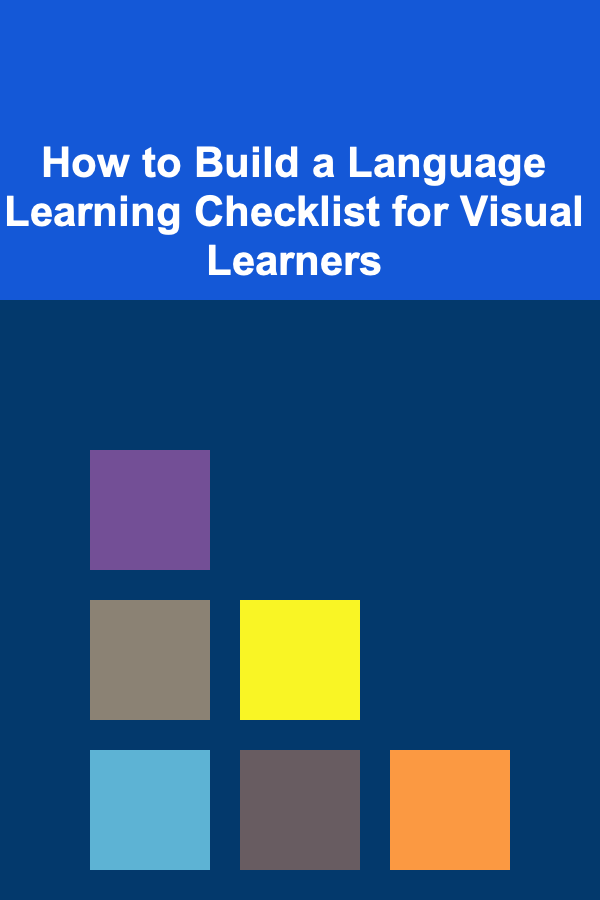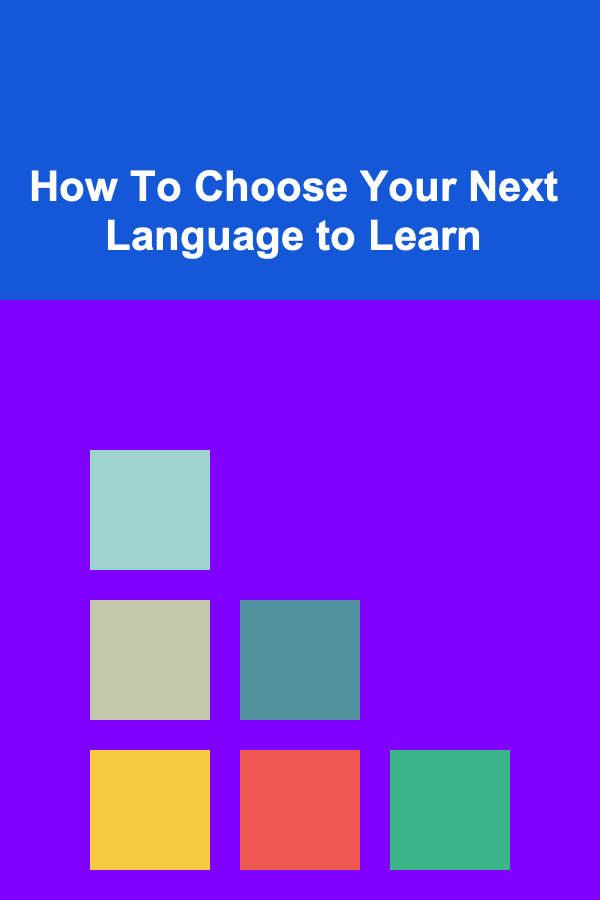
How to Build a Language Learning Checklist for Visual Learners
ebook include PDF & Audio bundle (Micro Guide)
$12.99$8.99
Limited Time Offer! Order within the next:

Learning a new language can be an exciting, transformative journey, but it can also be challenging, especially if you're trying to figure out the best methods to improve quickly. For visual learners, who absorb information best through images, diagrams, videos, and written text, the traditional methods of language learning might not be the most effective. Instead, visual learners need a more tailored approach that integrates visual stimuli into every step of the language acquisition process.
In this article, we will explore how to build a comprehensive language learning checklist that caters specifically to visual learners. By focusing on different visual techniques, tools, and strategies, you can accelerate your language learning while leveraging the strengths of your learning style.
Understand the Visual Learning Style
Before diving into the checklist, it's essential to recognize what a visual learner is and how they process information. Visual learners tend to grasp concepts more effectively when they are presented through visual aids such as charts, diagrams, flashcards, and videos. These learners prefer to see the information in front of them rather than just listening to it or reading it from a book.
Key characteristics of visual learners include:
- Preference for imagery: They understand and retain information better when it's accompanied by pictures, graphics, or charts.
- Good at recognizing patterns: Visual learners excel in identifying patterns in languages, such as sentence structures, word formations, and grammatical rules.
- Tendency to take notes visually: They often take notes using diagrams, mind maps, and other visual tools to organize information.
Understanding this learning style is crucial in building a checklist that will keep visual learners engaged, helping them retain and apply their new language skills more effectively.
Visual Learner's Language Learning Checklist
2.1 Use Color-Coded Notes and Flashcards
One of the simplest and most effective methods for visual learners is the use of color-coding. Color-coding can help learners categorize words, phrases, and grammatical structures, making it easier to recognize patterns and make associations between concepts. Here's how to incorporate this method into your language learning:
- Flashcards: Create digital or physical flashcards with images on one side and the target language word or phrase on the other. For example, for vocabulary related to food, you can have a picture of an apple and the word "apple" written on the opposite side. Use different colors to represent different categories of words like nouns, verbs, adjectives, etc.
- Color-coded Notes: When taking notes, use different colors to highlight parts of speech. For instance, write verbs in green, adjectives in blue, and nouns in red. This allows visual learners to quickly differentiate between various elements of language, which enhances retention.
- Mind Maps: Organize new vocabulary or grammar rules using mind maps. Start with a central theme, such as "travel," and branch out with words, phrases, or expressions related to that theme. Use color coding to differentiate between nouns, verbs, and adjectives to make the map visually distinct.
2.2 Incorporate Visual Grammar Guides
Visual learners often find it easier to grasp grammatical rules when they are presented through diagrams and visual aids. Grammar can sometimes be abstract or difficult to understand, but when it's illustrated with examples and visuals, it becomes much more approachable.
- Syntax Trees: Use syntax trees to break down sentence structures. These trees show how words are organized in a sentence and help learners understand sentence construction visually.
- Flowcharts: Create flowcharts for complex grammar rules. For instance, a flowchart for the use of different verb tenses (present, past, future) can be a helpful guide for visual learners to see how tenses change depending on context.
- Infographics: Use infographics that explain language rules or vocabulary with both visuals and text. Infographics that showcase the different parts of speech, conjugation patterns, or common expressions in the language can be particularly useful.
2.3 Use Videos and Movies with Subtitles
For visual learners, watching content in the target language is one of the most engaging and effective ways to improve their skills. Visual learners benefit from seeing body language, facial expressions, and the context of the conversation while simultaneously hearing the language.
- Watch Movies/TV Shows: Watching films and TV shows in your target language provides exposure to natural conversation, colloquialisms, and accents. Use subtitles to connect the written form with the spoken form of the language. Start by watching with subtitles in your native language, and then switch to subtitles in the target language to reinforce vocabulary.
- Educational YouTube Channels: There are countless YouTube channels dedicated to language learning that use visuals, animations, and subtitles to teach vocabulary, grammar, and cultural aspects of the language.
- Language Learning Apps with Video Integration: Some language learning platforms, like Duolingo and FluentU, use short video clips from real-life sources to teach language. These platforms can help you connect real-world language use with vocabulary and grammar in a visual format.
2.4 Create Visual Language Journals
A language journal is an excellent tool for visual learners because it offers a way to document and visualize progress. Creating a dedicated space for learning allows you to experiment with different visual methods to consolidate your learning.
- Draw Vocabulary: For every new word you learn, draw a picture that represents the meaning. For instance, for the word "apple," draw an apple. These drawings will reinforce the connection between the word and its meaning.
- Include Diagrams for Grammar: When learning new grammatical structures or verb conjugations, draw diagrams to visually map out the rules. For example, a timeline to represent the use of tenses can help you understand the flow of time and how it affects the verb forms.
- Use Visual Prompts: Place pictures, posters, or diagrams on the walls around your study area that feature new vocabulary or sentences in the target language. These visual prompts will serve as a constant reminder of new words or concepts, reinforcing your learning.
2.5 Interactive Language Learning Tools
Visual learners benefit from using interactive tools that engage multiple senses at once. Interactive tools allow learners to explore the language dynamically and see immediate feedback, which is important for reinforcing concepts visually.
- Language Learning Apps: Platforms like Memrise, Anki, and Babbel are highly visual and offer spaced repetition systems (SRS) for vocabulary building. They use images, videos, and flashcards to engage learners visually while reinforcing vocabulary.
- Interactive Quizzes: Take quizzes that include images, videos, and audio clips. For example, quizzes that show pictures and ask you to select the correct word in the target language are effective for reinforcing vocabulary.
- Language Games: Use gamified language-learning apps that feature visual-based games. Apps like Drops, which focus on image-based word learning, or Lingvist, which uses contextual learning with images, can help retain vocabulary and grammar.
2.6 Attend Language Immersion Programs with Visual Components
Another great way to learn a language visually is through immersion programs that include visuals in everyday language use. Language immersion helps learners develop their skills by surrounding them with the target language in real-life contexts.
- Language Immersion Camps: Some language immersion programs offer visual aids such as visual dictionaries, interactive workshops, and group activities that help reinforce language learning. By using objects, pictures, and actions, visual learners can engage with the language in a tangible way.
- Cultural Exchange Programs: Participating in a cultural exchange program allows you to experience the language in context, whether it's through visiting landmarks, attending cultural events, or interacting with native speakers.
2.7 Use Visual Mnemonics
Mnemonic devices are memory aids that help learners remember information more easily. For visual learners, visual mnemonics are especially effective because they involve associating images with words, phrases, or grammar rules. This can enhance recall and retention.
- Image Associations: Link a word in the target language to a memorable image. For instance, to remember the Spanish word "gato" (cat), you might imagine a cat wearing a hat (gato/hat). Creating vivid, exaggerated, or funny images helps solidify the connection in your memory.
- Mind Maps for Vocabulary: When learning vocabulary, create mind maps that visually link related words together. For example, you can create a central node for "weather" and branch out with words related to rain, snow, sun, etc.
Conclusion
Building a language learning checklist for visual learners is about harnessing the power of images, diagrams, and videos to facilitate better understanding, retention, and application of the language. By incorporating color-coded notes, visual grammar guides, videos with subtitles, interactive tools, and other visual aids into your study routine, you will be able to cater to your unique learning style and enhance your language acquisition process.
Remember, consistency is key. Use the checklist to ensure that you're consistently engaging with language through visual means, and over time, you'll notice significant improvements in your language skills. Whether you're a beginner or looking to refine your language proficiency, these visual methods will help you reach your language learning goals in an engaging and effective way.
Reading More From Our Other Websites
- [Home Staging 101] How to Enhance Your Kitchen with Simple Staging Tips
- [Organization Tip 101] How to Set Up a Functional Home Gym on a Budget
- [Home Party Planning 101] How to Create a Cozy and Inviting Atmosphere for Your Home Party
- [Home Rental Property 101] How to Prepare Your Rental for the Ultimate Movie Night: A Guide for Rentals with a Home Theater
- [Home Storage Solution 101] How to Use the KonMari Method for Effective Storage
- [Home Cleaning 101] How to Clean Your Home While Staying on a Budget
- [Organization Tip 101] How to Optimize Your Shower Space with Smart Storage
- [Personal Financial Planning 101] How to Track Your Expenses for Better Financial Management
- [Home Staging 101] How to Highlight Your Home's Best Features Through Staging
- [Organization Tip 101] Why You Should Create a Homework Station for Kids

How to Brighten Your Bathroom with the Right Lighting
Read More
How To Choose Your Next Language to Learn
Read More
How to Use Simple Decorations to Make Your Home Party Look Stunning
Read More
How To Optimize Your Controller Settings for Better Play
Read More
10 Tips for Perfect Cables in Your Knitting Projects
Read More
How to Display Your Stationery Set Beautifully
Read MoreOther Products

How to Brighten Your Bathroom with the Right Lighting
Read More
How To Choose Your Next Language to Learn
Read More
How to Use Simple Decorations to Make Your Home Party Look Stunning
Read More
How To Optimize Your Controller Settings for Better Play
Read More
10 Tips for Perfect Cables in Your Knitting Projects
Read More